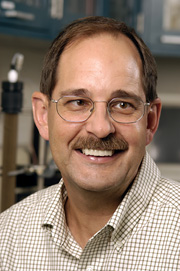
News Release
|
Office of News and Information Johns Hopkins University 901 South Bond Street, Suite 540 Baltimore, Maryland 21231 Phone: 443-287-9960 | Fax: 443-287-9920 |
Tuesday, June 7, 2005 FOR IMMEDIATE RELEASE CONTACT: Phil Sneiderman 443-287-9960 prs@jhu.edu |
and Ways to Manage Them
Researchers Want to Close Science Information Gaps
That Affect Cleanup Efforts
Drawing on experts in environmental engineering, biology, chemistry and other disciplines, The Johns Hopkins University has launched a new center to provide a more detailed understanding of hazardous contaminants in urban environments. One goal is to help regulators and property owners make better decisions regarding when pollutants need to be removed or neutralized — and how this can best be accomplished. Another aim is to assist regulators in establishing contamination limits.
The Center for Contaminant Transport, Fate and
Remediation (CTFR Center) will look at a broad range of
pollutants, including metals and organic materials that are
found in water, soil, sediment and air. Its initial focus
will be urban areas of the northeastern United States,
where many years of industrial development have left soil
and water supplies tainted with hazardous materials.
 Photo by Will Kirk |
Government agencies have adopted general rules that regulate what levels of pollution are unacceptable, but critical knowledge gaps exist, said Edward J. Bouwer, director of the new CTFR Center. For example, sediment — a mixture of soil and water — often contains more than one contaminant. "These chemicals may interact," he said. "It is difficult to make cleanup decisions based only on the limits allowed for a single pollutant."
The CTFR Center's first research sponsor, Honeywell International Inc., has provided funding to study chromium contamination in Baltimore's harbor. "Regulators are considering how much chromium should be permitted," Bouwer said. "But chromium can be present in two different forms, one significantly more toxic and more likely to migrate than the other. Before we can make cleanup recommendations, we have to figure out the precise chemical makeup of the sediment at the bottom of the harbor. There's a chemical 'soup' out there, and we have to tease out the most hazardous parts."
Richard Eskin, director of the Technical and Regulatory Services Administration within the Maryland Department of the Environment, said that "the chemistry controlling chromium behavior in estuaries is complex, and peer-reviewed research proposed by the center should be useful in providing a better understanding of the long-term behavior of chromium in the Baltimore harbor."
To explore contamination questions like this, including how pollutants are likely to move and what health threats they pose, the new CTFR Center will draw on more than a dozen faculty experts from three Johns Hopkins divisions — the Whiting School of Engineering, the Krieger School of Arts and Sciences and the Bloomberg School of Public Health — and from the University of Maryland, Baltimore County. Collaborative relations with other institutions are also planned.
These researchers will help the center develop a better understanding of physical, chemical and biological processes in order to detect, assess and manage the risks associated with the transport and fate of toxic chemicals in urban environments. "We plan to draw on a broad range of expertise to reduce the uncertainty that surrounds many contamination hazards and to make precise suggestions about remediation," said Bouwer, a professor in the Department of Geography and Environmental Engineering at Johns Hopkins.
"This new center promises to improve our basic understanding of environmental pollutants and the hazards they present," said Kim Coble, Maryland executive director of the Chesapeake Bay Foundation. "We believe the research conducted by these scientists will provide valuable help in efforts to restore the health of the Chesapeake Bay and preserve other priceless natural resources."
Each research project will be funded by a party that has a stake in the outcome of a particular contamination issue. These may include industrial firms, private property owners, local communities and government agencies. Bouwer emphasized, however, that the center will bring no pre- conceived bias to its research and will disseminate its findings publicly, regardless of what the scientists discover or who provided the funding.
"The purpose of the center is to provide independent, non-partisan research," Bouwer said. "The impartiality of the center is critical to its success. The people who fund our research can review the findings and make comments, but they can't restrain publication."
Related Links
Edward Bouwer's Web page
Johns Hopkins Department of Geography and Environmental
Engineering
|
Johns Hopkins University news releases can be found on the
World Wide Web at
http://www.jhu.edu/news_info/news/ Information on automatic e-mail delivery of science and medical news releases is available at the same address.
|
 Go to
Headlines@HopkinsHome Page
Go to
Headlines@HopkinsHome Page